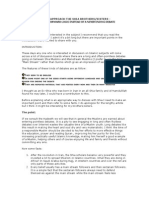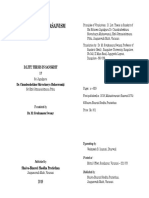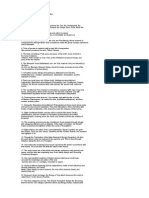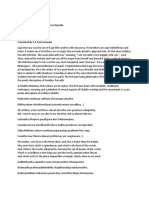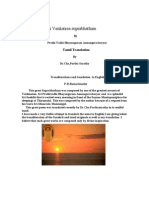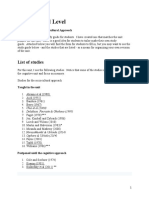Sri Gurubhyo Namaha
Sri Gurubhyo Namaha
Uploaded by
Venkat JayCopyright:
Available Formats
Sri Gurubhyo Namaha
Sri Gurubhyo Namaha
Uploaded by
Venkat JayCopyright
Available Formats
Share this document
Did you find this document useful?
Is this content inappropriate?
Copyright:
Available Formats
Sri Gurubhyo Namaha
Sri Gurubhyo Namaha
Uploaded by
Venkat JayCopyright:
Available Formats
Sri Gurubhyo Namaha Vedic Chanting a Perfectly Formulated Oral Tradition Dr. S.
. YEGNASUBRAMANIAN Our tradition believes that the Vedas are the breath of God Himself! With that belief, our Rishis exercised enormous care to preserve the Vedas in its original form without the infiltration of any errors. Especially in the absence of writing, and through only an oral transmission from father-to- son or teacher-to-disciple, for thousands of years, this is an accomplishment of unimaginable proportion! Considering the vast magnitude of mantras contained in the vedas, such a preservation, with built-in safeguards, is mind boggling! It is believed that the complete benefit of Veda mantras could be achieved only when the following conditions are met: Correct pronunciation of letters (words) Correct duration for utterance of letters (words) and, Correct intonation of letters, Our Rishis prescribed several fool-proof methods to correctly recite the veda mantras. Six ways of recitation were considered incorrect and they are : One who chants in a sing-song fashion , who chants fast , who nods his head up and down without actually raising or lowering the pitch , who reads from a book , who chants without knowing the meaning , and who chants in a feeble voice , are considered Vedic Chanting - A Perfectly Formulated Oral Tradition Page 1 of 6 file://C:\journal\vol1no2\chanting.html 9/7/2007incorrect . They believed that altering the pitch even (without any change in words and duration), might lead to diametrically opposite effects, as related in the story of Vrtra who, instead of killing Indra, got killed by Indra by just a change in the intonation alone of the mantras chanted by Vrtras father, Tvashta. The rules of correct pronunciation and articulation of sounds are given in the Vedanga, known as Seeksha. Seeksha deals with varNa (letters), svara: (pitch); [there are essentially three svaras, namely, anudatta (gravely accented or low pitched), udatta (high pitched or acutely accented), svarita (circumflexly accented)] maatraa (duration a prosodial unit of time); balam (strength or force of articulation); saama (uniformity); and santaana: (continuity) during recitation. Our ancestors devised unique methods to protect and maintain the basic Veda mantras in its original form through various patterns and combinations of recitation. The basic mantra is called vakya or
samhita paatha which is a full sentence. Splitting them word by word is known as pada paatha , which gives the knowledge of each word to the student. Next is krama paatha , where the first word of the mantra is added to the second, the second to the third and so on, until the whole mantra is completed. This method enables the student not only to know individual words but also how to combine words in recitation and the changes in svara that occur as a result of such combination. Both Pada and Krama methods of chanting retain the natural order of words of the samhita paatha and so, are known as prakrti or natural. For example, if we take sentence consisting of six words a-b-c-d-e-f, in samhita paatha, it will be chanted as six separate words a, b, c, d, e and f in pada paatha will be recited as a-b, b-c, c-d, d-e, and e-f in krama paatha. Actually, a reciter proficient in chanting in the krama format is honored as a kramavit ! Samhita paatha Vedic Chanting - A Perfectly Formulated Oral Tradition Page 2 of 6 file://C:\journal\vol1no2\chanting.html 9/7/2007Pada paatha Krama paatha In addition, they devised eight other combinations which do not follow the natural order, and are known as vikriti or artificial order. The vikritis are given in the following verse: They are, jataa, maalaa, sikhaa, rekhaa, dhwaja, danda, ratha and ghana. Among these only jataa and ghana are prevalent (or, only !) practices in the Krishna Yajur Veda which is mostly predominant in the South. In Sukla Yajur Veda, which is mostly predominant in Banaras and in the North, (the Madhyandina and Kanva schools) all the eight vikritis were practiced. However, today, there may not be any scholars at all who might know all these vikritis Jataa (braid) paatha In the above example, the six words in the line, when chanted in the jataa format becomes, a-b-b-a-a-b; b-c-c-b-b-c; c-d-d-c-c-d; d-e-ed-d-e; e-f-f-e-e-f and so on. As can be seen, the forward-reverseforward arrangement of words resemble the way ladies braid their hair, and so this practice of chanting is termed jataa! Maalaa sikhaa, rekhaa, dhwaja, danda, and ratha paathas Two types of maalaa (garland) exist: a)krama maalaa and b) Vedic Chanting - A Perfectly Formulated Oral Tradition Page 3 of 6 file://C:\journal\vol1no2\chanting.html 9/7/2007pushpa maalaa. This is simialr to krama paatha in that two-word units with the characteristic overlapping are the foundation. sikhaa (top knot) is similar to jataa except that, instead of two words being repeated forwards and backwards, three words are linked. Recitations in rekhaa (row), dhwaja (flag), dand (staff), and ratha (chariot) are more complex and the reader can refer to Wayne
Howard [2] for details. Mention can be made here that there are three of ratha, namely, dvipaada (two wheels), tripaada (three wheels) and catuspaada (4 wheels). Each wheel corresponds to a quarter verse (paada) of the text. Among these, dvipaada catuspaada varieties are the ratha types most widely cultivated today. Ghana (bell) paatha This is one of the most popular format of recitations and requires years of learning and practice by the student. A scholar proficient in recitation in this format is honored as a ghana paathi . Here the arrangement of words take the shape of a bell. For example, the group of words a-b-c-d-e-f mentioned earlier, when chanted in the ghana format will be, a-b-b-a-a-b-c-c-b-a-a-bc; b-c-c-b-b-c-d-d-c-b-bd; and so on. The earliar illustration of six words, when written in ghana format will appear as follows: Please note that, what was originally six words in the samhita, evolve in to about sixty words in the ghana format a ten fold increase in this case that gives an idea of how complex the chanting can become with larger sections of the mantras !! We can now appreciate the rigor a ghana pathi has to go through in his education to learn, by heart, the thousands of mantras, to be able to recite in ghana format. Vedic Chanting - A Perfectly Formulated Oral Tradition Page 4 of 6 file://C:\journal\vol1no2\chanting.html 9/7/2007Our Rishis devised all these elaborate and complicated system of chanting in order to preserve the purity of the sound, word, pronunciation, intonation , pitch and sound combination of the veda mantras which are the foundation for our sanaatana dharma itself. Also, repetition of words in many ways, the correct tally of words was also maintained which ensured the purity. They also believed that higher merits (punya) accompany greater complexities in chanting for example, a ghana recitation is several orders higher in merit than jataa recitation, which is higher in merit than krama recitation and so on. Wayne Howard [2] noted in the preface of his book, "Vedic Recitation in Varanasi", "The four Vedas (Rg, Yajur, Sama and Atharva) are not "books" in the usual sense, though within the past hundred years each veda has appeared in several printed editions. They are comprised rather of tonally accented verses and hypnotic, abstruse melodies whose proper realizations demand oral instead of visual transmission. They are robbed of their essence when transferred to paper, for without the human element the innumerable nuances and fine intonations inseparable and necessary components of all four compilations - are lost completely. The ultimate authority in Vedic matters is never the
printed page but rather the few members who are today keeping the centuries-old traditions alive." It is unfortunate that there is very little subscription to this education these days and it is an important duty of all of us to ensure that this education is encouraged and adequate support is given to promote and propagate it. References 1. "The Vedas", Bharatiya Vidya Bhavan, Bombay 1988. 2. "Veda Recitation in Varanasi", Wayne Howard, Motilal Banarasidass, Delhi 1986. - Dr. S. Yegnasubramanian ( President, SVBF) is a scientist at Bell Labs., NJ. He has been teaching vedic recitation & vedanta for several years. Feature Article of Next Issue The Vedangas (Organs of the Vedas) Vedic Chanting - A Perfectly Formulated Oral Tradition Page 5 of 6 file://C:\journal\vol1no2\chanting.html 9/7/2007Vedic Chanting - A Perfectly Formulated Oral Tradition Page 6 of 6 file://C:\journal\vol1no2\chanting.html 9/7/2007
You might also like
- How To Give Dawah To ShiasDocument32 pagesHow To Give Dawah To ShiasFaisal Umer100% (1)
- AghDocument5 pagesAghkadvarNo ratings yet
- Barcelona Pavilion: Mies Van Der RoheDocument32 pagesBarcelona Pavilion: Mies Van Der RoheLuis Araya CollaoNo ratings yet
- Sanmati TarkaDocument434 pagesSanmati TarkaHasibuan SantosaNo ratings yet
- Principles of VirashaivismDocument420 pagesPrinciples of VirashaivismVeeresh BT83% (6)
- Yadavabhyudaya by Vedanta Desika - English Translation PDFDocument254 pagesYadavabhyudaya by Vedanta Desika - English Translation PDFsandeep PNo ratings yet
- DRR in SchoolsDocument24 pagesDRR in SchoolsAsean Drr PortalNo ratings yet
- AAS Application Form SampleDocument22 pagesAAS Application Form SamplePopy InthavongNo ratings yet
- Mumukshupadi Part 1 PDFDocument50 pagesMumukshupadi Part 1 PDFenota15No ratings yet
- Guhyakali Upanishad (Secret Upanishads)Document12 pagesGuhyakali Upanishad (Secret Upanishads)sriramtheatmanNo ratings yet
- Adhikara BhedaDocument6 pagesAdhikara Bhedaसूर्य नारायण शर्मा0% (1)
- Vaikrtika Rahasya - The Mystery of The TransformationsDocument7 pagesVaikrtika Rahasya - The Mystery of The TransformationsRamesh RajagopalanNo ratings yet
- Tattva Prakasha 24 Iz 76Document2 pagesTattva Prakasha 24 Iz 76Виталий Александрович100% (1)
- 2 Tattvabodha SadhanaChatushtayamDocument4 pages2 Tattvabodha SadhanaChatushtayamchandusgNo ratings yet
- Devi Atharvashirsha EnglishDocument3 pagesDevi Atharvashirsha EnglishPraveen SmartNo ratings yet
- Indian Scriptures: Vidya GitaDocument3 pagesIndian Scriptures: Vidya GitaMaheshawanukarNo ratings yet
- 2010 Blossom 14 Petal 4Document18 pages2010 Blossom 14 Petal 4egauthamNo ratings yet
- AKshara List of The Sanskrit Inscription of Feilai Peak, Hangzhou, China (1282 - 1292 AD) - Ye ShaoyongDocument4 pagesAKshara List of The Sanskrit Inscription of Feilai Peak, Hangzhou, China (1282 - 1292 AD) - Ye Shaoyongsktkoshas100% (1)
- Tripura Strotas FiDocument78 pagesTripura Strotas FirishiNo ratings yet
- Bala Muktavali StotraDocument2 pagesBala Muktavali StotraKambhampati SandilyaNo ratings yet
- Narasimha Raja Patha StotramDocument4 pagesNarasimha Raja Patha StotramPuducode Rama Iyer RamachanderNo ratings yet
- The Brahmā StutiDocument11 pagesThe Brahmā StutiDurga DeviNo ratings yet
- Bala StotramDocument2 pagesBala StotramAnonymous VdXFPOvGxNo ratings yet
- Tantra and Kamakala PDFDocument158 pagesTantra and Kamakala PDFPiyus NathNo ratings yet
- Maha ShivaratriDocument46 pagesMaha Shivaratrinitin kapoorNo ratings yet
- The Brahmanda Purana Part III - Ganesh Vasudeo Tagare - 1984 - Motilal Banarsidass - Anna's ArchDocument258 pagesThe Brahmanda Purana Part III - Ganesh Vasudeo Tagare - 1984 - Motilal Banarsidass - Anna's ArchstevendusmentNo ratings yet
- Vyatipatha Yoga PoojaDocument3 pagesVyatipatha Yoga PoojaEmrald ConsultancyNo ratings yet
- The Structure of Maha MeruDocument4 pagesThe Structure of Maha MeruPawan MadanNo ratings yet
- Saiva Siddhanta Tatva Prakasam CatechismDocument13 pagesSaiva Siddhanta Tatva Prakasam CatechismSivasonNo ratings yet
- Ganesha Manasa PoojaDocument19 pagesGanesha Manasa PoojarkmgurumaharajNo ratings yet
- Lopamudra The Holy MotherDocument1 pageLopamudra The Holy MotherAdwaita YogiNo ratings yet
- Secrets of Sri Chakra1Document3 pagesSecrets of Sri Chakra1vipinsunariaNo ratings yet
- Tips Taittiriya Upanishad Tns CompleteDocument58 pagesTips Taittiriya Upanishad Tns CompleteelecsudNo ratings yet
- Sri Tattva Muktavali or Sri Mayavada Sata DusaniDocument26 pagesSri Tattva Muktavali or Sri Mayavada Sata DusaniRadha K das100% (1)
- Bali DanaDocument2 pagesBali DanaArun Naik100% (1)
- Yanmandalam Gayatri Stavan Hindi Sanskrit Lyrics PDFDocument4 pagesYanmandalam Gayatri Stavan Hindi Sanskrit Lyrics PDFAbhishek JoshiNo ratings yet
- Saiva Siddhanta PDFDocument6 pagesSaiva Siddhanta PDFAl MillerNo ratings yet
- AYURVEDA-1 - Mehakdeep SinghDocument11 pagesAYURVEDA-1 - Mehakdeep SinghPRIYADARSHININo ratings yet
- Caitanya Candramrita - Prabodhananda SarasvatiDocument20 pagesCaitanya Candramrita - Prabodhananda SarasvatiLajaluMuskanNo ratings yet
- Pramana-S in SaivasiddhantaDocument11 pagesPramana-S in SaivasiddhantasiddhantaNo ratings yet
- Saiva Agama 2Document2 pagesSaiva Agama 212karsNo ratings yet
- Aspects of Saiva WorshipDocument12 pagesAspects of Saiva WorshipSivasonNo ratings yet
- Sri Mayavada-Sata-DushaniDocument11 pagesSri Mayavada-Sata-DushaniDavor VeseljkoNo ratings yet
- Sri Ranga GadyamDocument3 pagesSri Ranga Gadyamapi-273088978No ratings yet
- JnanamritaDocument55 pagesJnanamritaRaviNo ratings yet
- Devi Vaibhava Ashcharya Ashtottara Shata Divyanama StotramDocument7 pagesDevi Vaibhava Ashcharya Ashtottara Shata Divyanama StotramAnanda NathaNo ratings yet
- AnandalahariDocument5 pagesAnandalahariGyanaRaghavan-chamuNo ratings yet
- Raurava Agama Vdya PadaDocument109 pagesRaurava Agama Vdya Padaaghorishiva100% (2)
- Visvajite SuktamDocument3 pagesVisvajite Suktamsateesh100% (1)
- Thathva Thrayam EnglishDocument32 pagesThathva Thrayam EnglishSarathy ThothathriNo ratings yet
- Veda para Yan AmDocument8 pagesVeda para Yan AmKaushikmahadev NarayananNo ratings yet
- Sivapprakasam சிவப்பிரகாசம் Www.bhagavadgitausa.com/ Sivapprakasam.htm. SivaprakAsam by UmA-pathi-SivaNAr 1308 C.E. - உமாபதிசிவணார். காலம்: கி.பி.1308Document96 pagesSivapprakasam சிவப்பிரகாசம் Www.bhagavadgitausa.com/ Sivapprakasam.htm. SivaprakAsam by UmA-pathi-SivaNAr 1308 C.E. - உமாபதிசிவணார். காலம்: கி.பி.1308krishnarajmdNo ratings yet
- YajnavalkyaDocument5 pagesYajnavalkyahjoshi1297No ratings yet
- SUTRA VAHINI-By Bhagawan Sri Sathya Sai BabaDocument27 pagesSUTRA VAHINI-By Bhagawan Sri Sathya Sai Babaapi-3824575No ratings yet
- Muthuswami Dikshitar Lec DemDocument18 pagesMuthuswami Dikshitar Lec Dembalakris_ananthNo ratings yet
- Sri Kamala Ashtottara Satanama StotramDocument4 pagesSri Kamala Ashtottara Satanama StotramRavi MehraNo ratings yet
- Shivanandalahari English Translation PDFDocument42 pagesShivanandalahari English Translation PDFSwami BhaskaranandaNo ratings yet
- The Birth of the War-God A Poem by KalidasaFrom EverandThe Birth of the War-God A Poem by KalidasaNo ratings yet
- Om Chanting: Om Chanting Meditation for Wellness, Balance, and Enlightenment: Religion and SpiritualityFrom EverandOm Chanting: Om Chanting Meditation for Wellness, Balance, and Enlightenment: Religion and SpiritualityNo ratings yet
- Venkatesa SuprabhatamDocument16 pagesVenkatesa SuprabhatamPuducode Rama Iyer RamachanderNo ratings yet
- Guidelines For Shielded Metal Arc Welding (SMAW)Document28 pagesGuidelines For Shielded Metal Arc Welding (SMAW)soroush1111No ratings yet
- Problem ManagementDocument51 pagesProblem ManagementVenkat Jay50% (2)
- Astrological Table English PDFDocument42 pagesAstrological Table English PDFVenkat JayNo ratings yet
- Welding and Allied ProcessesDocument48 pagesWelding and Allied Processesayush9588No ratings yet
- Puranas 15Document33 pagesPuranas 15Venkat JayNo ratings yet
- Kundalini, The Mother of The UniverseDocument39 pagesKundalini, The Mother of The UniverseVenkat JayNo ratings yet
- Problem SolvingDocument230 pagesProblem SolvingVenkat JayNo ratings yet
- Autotransformer: OperationDocument5 pagesAutotransformer: OperationVenkat JayNo ratings yet
- Kundalini, The Mother of The UniverseDocument39 pagesKundalini, The Mother of The UniverseVenkat JayNo ratings yet
- NLP For Personality DevelopmentDocument15 pagesNLP For Personality DevelopmentVenkat JayNo ratings yet
- Diet in HinduismDocument11 pagesDiet in HinduismVenkat JayNo ratings yet
- 8 Yoga Mudras To Overcome Any AilmentsDocument9 pages8 Yoga Mudras To Overcome Any AilmentsVenkat JayNo ratings yet
- Body LanguageDocument139 pagesBody LanguageVenkat JayNo ratings yet
- Chandogya UpanishadDocument7 pagesChandogya UpanishadVenkat JayNo ratings yet
- Combination of PlanetsDocument22 pagesCombination of PlanetsVenkat Jay0% (1)
- 8 Yoga Mudras To Overcome Any AilmentsDocument9 pages8 Yoga Mudras To Overcome Any AilmentsVenkat JayNo ratings yet
- 8 Yoga Mudras To Overcome Any AilmentsDocument9 pages8 Yoga Mudras To Overcome Any AilmentsVenkat JayNo ratings yet
- Course Title: Date: Venue: Facilitator Name: Name (Optional)Document2 pagesCourse Title: Date: Venue: Facilitator Name: Name (Optional)Venkat JayNo ratings yet
- 26islanders - Mp3: Speakers: Hans Skalle, WW Websphere Value Selling, Ibm Swanie Tolentino, Senior Marketing Manager, BPMDocument3 pages26islanders - Mp3: Speakers: Hans Skalle, WW Websphere Value Selling, Ibm Swanie Tolentino, Senior Marketing Manager, BPMVenkat JayNo ratings yet
- III-Day 5Document3 pagesIII-Day 5Polix Abule Jr.No ratings yet
- Dissertation Article 1134 Code CivilDocument4 pagesDissertation Article 1134 Code CivilBuyAPaperSingapore100% (1)
- 030 Ice 01 Result Dec10 InsDocument41 pages030 Ice 01 Result Dec10 InsDevanshu AnandNo ratings yet
- Diagnosing Organizational EffectivenessDocument59 pagesDiagnosing Organizational EffectivenessMunir AhmadNo ratings yet
- Grade 4: Daily Lesson LogDocument43 pagesGrade 4: Daily Lesson Loglaliane taga-anNo ratings yet
- 20211006-COOP Report-TemplateDocument4 pages20211006-COOP Report-Templatequân đặngNo ratings yet
- Gmail - Vice Chancellor Internship Scheme - Part-Time Internship 2023 Registration FormDocument4 pagesGmail - Vice Chancellor Internship Scheme - Part-Time Internship 2023 Registration FormCharu SharmaNo ratings yet
- Emptech Activity Cot 1Document9 pagesEmptech Activity Cot 1Arvin Barrientos BernestoNo ratings yet
- UnitDocument25 pagesUnitapi-251450164No ratings yet
- RajdhaniDocument3 pagesRajdhaniKaranGargNo ratings yet
- Master Organic Chemistry SubstitutionDocument43 pagesMaster Organic Chemistry SubstitutionArsalan Khan GhauriNo ratings yet
- 1.enrichment Activities For Respiratory and Circulatory SystemDocument31 pages1.enrichment Activities For Respiratory and Circulatory SystemMarilyn Castro LaquindanumNo ratings yet
- GMAT Prep English VersionDocument38 pagesGMAT Prep English VersionGaurav JainNo ratings yet
- Exercises For Interpretation PracticeDocument5 pagesExercises For Interpretation PracticetinydaisyNo ratings yet
- Bayes and MCMC For Undergraduates: The American StatisticianDocument7 pagesBayes and MCMC For Undergraduates: The American StatisticianSigit WahyudiNo ratings yet
- School Monitoring Evaluation AdjustmentDocument3 pagesSchool Monitoring Evaluation AdjustmentConsuegra Elementary School0% (1)
- Cultural ConservationDocument8 pagesCultural Conservation60 984No ratings yet
- Sultan Kudarat State UniversityDocument2 pagesSultan Kudarat State UniversityVanessa Joyce OgatisNo ratings yet
- Chapter 1 - Intro To Management and OrganizationDocument22 pagesChapter 1 - Intro To Management and OrganizationDanday PorterNo ratings yet
- Measurable Performance Indicators of Student Learning Outcomes: A Case StudyDocument12 pagesMeasurable Performance Indicators of Student Learning Outcomes: A Case StudysatishNo ratings yet
- Stop Wasting Time Speak English With VanessaDocument3 pagesStop Wasting Time Speak English With VanessaJesús OlivierNo ratings yet
- HR For Principals (Readings)Document11 pagesHR For Principals (Readings)Jenelou John IsraelNo ratings yet
- Sociocultural Student Book John CraneDocument61 pagesSociocultural Student Book John CranePedro Mauricio Pineda LópezNo ratings yet
- SavedrecsDocument1,440 pagesSavedrecsAshish AhirwalNo ratings yet
- Explication of Ineffective Group Communications Among The NDGM SHS Sector Through Online Mode of Learning A Qualitative Study KOLBE 3Document83 pagesExplication of Ineffective Group Communications Among The NDGM SHS Sector Through Online Mode of Learning A Qualitative Study KOLBE 3Barrera, Kurt BenedictNo ratings yet
- Unit 4 Study Guide Answer KeyDocument5 pagesUnit 4 Study Guide Answer Keyapi-328550972100% (1)
